| Article ID | Journal | Published Year | Pages | File Type |
|---|---|---|---|---|
| 3344723 | Clinical Microbiology Newsletter | 2016 | 9 Pages |
In recent years, the emergence of multidrug-resistant Gram-negative rods and a dwindling antimicrobial armamentarium has led to renewed use of the polymyxins. With increasing use of polymyxins, there has been increase in resistance among previously susceptible populations of Pseudomonas aeruginosa, Klebsiella pneumoniae, and Acinetobacter baumannii. Unfortunately, susceptibility testing for the polymyxins is fraught with difficulties, making clinically informative interpretation of these tests challenging. Among the key factors, the physiochemical properties of polymyxins make them difficult to diffuse through agar, compromising the performance of disk diffusion and Etest methods. Polymyxins also interact with polystyrene microtiter plates, resulting in great variability in MIC results, especially at low concentrations of the drug. There are no U.S. Food and Drug Administration (FDA)-cleared automated commercial systems currently available for susceptibility testing. This review evaluates polymyxin B and colistin modes of action, mechanisms of resistance, and susceptibility testing methods.
